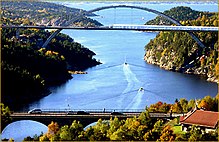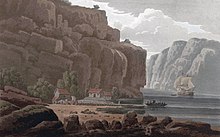Svinesund


Malet af John William Edy omkring 1800.
Svinesund er et grænsested nær Halden og Strömstad. Her forenes Norge og Sverige over fjorden, som på den svenske side kaldes Idefjorden, mens fjorden på den norske side hedder Ringdalsfjorden. Når man kommer længere ind i fjorden, kaldes den på norsk side Iddefjorden.
Navnet kan vise til "svin", dvs. skær i sundet. Strømmen under broen kan gøre 3 knop. Ved det tidligere færgested nede ved fjorden står stadig hovedbygningen, Søylegården, fra 1726, hvor poststed og toldstation holdt til. Øst for den gamle bro ligger Hjelmkollen med grensefæstningen,[1] der blev nedlagt i 1905.[2]
En ny bro over Svinesund, Svinesundbroen, blev officielt åbnet den 10. juni 2005 af Norges kong Harald og Sveriges kong Carl Gustaf.[3] Den nye Svinesundsbro åbnede for regulær trafik to dage senere. Den 1. juli 2005 begyndte man at opkræve bompenge.
Trafikken over Svinesund fordeler sig med 75 % på den ny bro og 25 % på den gamle [4]. I 2010 passeredes den ny bro i snit af 15.524 køretøjer pr. dag, mens 5.336 passerede den gamle bro. I 2002, altså inden den ny bro blev åbnet, var den gennemsnitlige døgntrafik på 17.352 køretøjer.
Det er kun ved den gamle bro fra 1946, man kan stoppe og betragte udsigten.
Mere end 100 bopladser fra stenalderen er fundet på egnen.[5]
Kilder
Medier brugt på denne side
Forfatter/Opretter: Bård Halvorsen, Licens: CC BY-SA 3.0
The new bridge over the Svinesund.
| No. LXXIX. NORWEGIAN SIDE OF SVINESUND. |
|---|
|
From the post-house at Helle, the high road winds through a wild country to the precipitous boundary, between Sweden and Norway, called Svinesund. Within about half a mile of it, a single separation between the mountains, discovers a tremendous descent strewn with masses and fragments of rocks, where with great labour, a kind of road has been made down to the ferry, which latter, at particular times of the day, owing to the usual gloom, is horribly magnificent and imperfectly seen at the bottom, where the water is very deep, and appears as black as ink. The coup d'æil, with the sudden and difficult declivity, affects the frame with an involuntary tremor, until the traveller is advised to quit his carriage and use great caution in descending it on foot. In seasons when the road is slippery, ropes are used to check the velocity which the carriages may acquire in the descent, but this contrivance is for travelling carriages only. The vehicle in general use here, is a long kind of box on four wheels, six or eight inches diameter, containing two or three persons in low seats, vis a vis ; it is drawn by one horse. The traveller in a carriage drives four abreast. The rocks and fragments in the way, being on so large a scale, the mmd is kept in a continued state of alarm, lest one of them should be disposed to quit its resting-place, and follow in the tram. On arriving at the bottom, the silence and gloom impress the beholder with the belief of being immured in a vast cavern, whose perpendicular sides seem to meet above the clouds; and he may here fancy himself about to cross the river Styx. The stupendous rocks, over the house,on this the Norwegian side of the view, are only warts, or mole-hills, compared with the others seen behind, when looking back up the road we have descended, or in the opposite direction into Sweden. At the house is performed the double duty of inspecting, receiving and granting passports, and of affording other personal accommodations, as at an inn. Although the water receives such a dark complexion from its depth and situation, in a glass it is pure as crystal, but saline. At this place it is about a quarter of a mile over; the ferryboat is large and flat, sufficiently ample for conveying two carriages, their horses and necessary attendants. The horses are not unharnessed, but draw the vehicle in and out by means of a convenient platform on each side of the river, to which the head of the boat is affixed, and its side to a causeway for the foot passengers. Travellers however generally sit in their carriages, all the way over. This place is so encompassed with rocks, that the water seldom presents a rough surface, neither is there any tide. The stream glides gently from a long chain of lakes above the town of Frederickshall, to which there is an uninterrupted navigation. The ship introduced is supposed to be sailing from that place. The rocks behind it, form the equally bold termination of the coast of Sweden.
|

